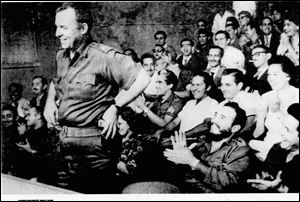
TELEVISION
Toledoan’s part in Cuban revolution told on PBS special
11/15/2015
Billy Morgan of Toledo with Cuba’s Fidel Castro in the front row.
The transformation of Billy Morgan from youthful scofflaw to freedom fighter and eventual martyr is at the heart of American Comandante, the latest installment of PBS’ American Experience series, which charts the unlikely role one Toledoan played in the Cuban revolution.
Based in part on a 2015 book by former Blade reporters Mike Sallah and Mitch Weiss, the program (airing at 9 p.m. Tuesday on WGTE-TV, Channel 30 and WBGU-TV, Channel 27) takes viewers from Collingwood Boulevard to the jungles of Cuba between the mid 1940s and early ’60s.
It’s a curious tale, not just because of its derring-do patina, but because most Americans have never heard of Morgan or his role in the creation of modern Cuba.
WGTE-TV, Channel 30 invites the public to a free early screening of ‘American Comandante.’
When: 2 p.m. today .
Where: 1270 S. Detroit Ave.
Doors open at 1:30 p.m. The screening will be preceded by remarks from show producer Ariana Bosch. William Morgan’s widow, Olga Rodriguez Morgan Goodwin, also will be in attendance.
“There was a time [when] it wasn’t such a far off idea that an American would be fighting in the Cuban Revolution,” producer Ariana Bosch said from her home in Miami. She will be in Toledo today for a special advance screening of the show at WGTE’s studios. “As a Cuban-American, I knew he fought in Cuba. He was a national hero. There were even popular songs written about Morgan at that time. And then he disappeared. You can’t find him in the history books in Cuba.”
Using the Sallah-Weiss book as their template, Bosch’s production team re-interviewed many of their sources, then conducted additional research, including contacting Morgan’s sister who provided a treasure trove of visual material.
“One lucky thing that happened was we found the 8mm films of his childhood taken by his father. Those were in the hands of his sister which allowed us to have a record of Morgan and Toledo at the time. It began to make sense who he was as a person. That was very enriching. When we first started all we had was a yearbook photo.”
William Morgan was born into an upper middle-class Ohio family, a spirited child whose knack for finding trouble grew as he aged. At 14 he ran away and joined the circus. By 20 he was spending time in a federal prison for deserting the army. He did odd jobs for the Toledo mob, and later moved to Miami and married a snake charmer. Yet even as he continued to hang with mobsters, Morgan discovered an exile community bent on fomenting revolt in nearby Cuba.
Morgan began by smuggling guns to the island’s rebels, but soon graduated to joining the Second Front, an armed group in the Escambray Mountains where his bravery got him promoted to the rank of comandante. He became front page news in American papers: the gringo helping to overthrow Fulgencio Batista.
That overthrow took place in 1959, and that’s when Morgan’s troubles really began. The Second Front was a rival group to Fidel Castro’s insurgent army, and when Castro assumed control of the country and began flirting with Russia, Morgan and his cohorts again took to the hills. The man whose liberation theology he had once supported was now his enemy.
He was eventually captured and executed by Castro’s government on March 11, 1961.
If those are the bare bones of Morgan’s story, American Comandante does an expert job of giving what happened context. Its one advantage over the Sallah-Weiss book is its use of moving images, from home movies dating back to Morgan’s childhood, to newsreel footage of his life in Cuba. We see the pudgy but determined child, the feckless GI and, finally, the fearless revolutionary who resisted efforts by Che Guevara to take control of his “Tigers of the jungle.”
There’s also strength in those interviewed for the documentary, from men who fought beside Morgan to his widow, Olga, who still lives in Toledo. She met him as a young woman when he was already a star with the Second Front. She bore him two children and spent 10 years in prison following his execution, before being allowed to immigrate to the United States.
That said, the show could use more political back story. We understand why Castro wanted to erase William Morgan’s name from history, but why would FBI director J. Edgar Hoover go to such lengths to get Morgan’s citizenship revoked? [Olga has since had it successfully restored.] And what exactly were these mob ties that would later involve him in a plot to kill Castro?
Producer Bosch admits some initial uncertainty about William Morgan’s story.
“We wondered what if our own sense of his importance was somewhat exaggerated? But as we worked on this show, we kept finding interviews and headlines, not just the Toledo Blade, but the New York Times and Miami newspapers. More and more we realized that he had occupied an important place at this time in Cuba.”
Ultimately what fascinates us about the American Comandante is his ability to do what so many others have dreamed off: Take a lifetime of failures and reinvent yourself as a hero.
Contact Mike Pearson at mpearson@theblade.com or 419-724-6159.